 This fun little build was done for the July 2010 NWSM display at the Museum of Flight called "Strangers in a Strange Land", which displayed captured enemy aircraft in markings other than their own. In searching for a suitable candidate, I remembered an American Aviation Historical Society (AAHS) article about a couple of Me-109s captured in North Africa and painted in American markings, which would fit the bill perfectly. I rummaged about in my stack of reference materials, and there it was - in the Fall 1965, Vol. 10, No. 3 issue of the AAHS Journal, was an article entitled "Checkertails - History of the 325th Fighter Group Part I, August 1942 - May 1944", by Ernst R. McDowell. On page 162 of the Journal, the article included a short history, two photographs of captured Me-109s, and a description of how the Me-109G nick-named "Hoimann" was repainted in American markings.
This fun little build was done for the July 2010 NWSM display at the Museum of Flight called "Strangers in a Strange Land", which displayed captured enemy aircraft in markings other than their own. In searching for a suitable candidate, I remembered an American Aviation Historical Society (AAHS) article about a couple of Me-109s captured in North Africa and painted in American markings, which would fit the bill perfectly. I rummaged about in my stack of reference materials, and there it was - in the Fall 1965, Vol. 10, No. 3 issue of the AAHS Journal, was an article entitled "Checkertails - History of the 325th Fighter Group Part I, August 1942 - May 1944", by Ernst R. McDowell. On page 162 of the Journal, the article included a short history, two photographs of captured Me-109s, and a description of how the Me-109G nick-named "Hoimann" was repainted in American markings.
The Me-109G nick-named "hoimann" would be perfect for the coming NWSM display.
"hoimann" was used by the Checkertails to familiarize new pilots with the flying characteristics of the Me-109, and in one case, to take revenge for the poor performance of their escorts on a mission. The following is an excerpt from the AAHS article detailing the episode:
"The last straw came on a mission when the top cover that was to have been provided by the 14th Fighter Group, failed to materialize when needed most. Major Robert Baseler felt that these lads had spotted a Jerry and then the whole group had gone tearing off after him. Fortunately, no one was lost, but the Clan's P-40s had a few more bullet holes than would have been their normal quota had they been given the proper cover. Getting back to base, Major Baseler had the ground crew roll out "Hoimann," the liberated Me 109G that had been obtained when North Africa fell. "Hoimann" was painted a matte black all over with a red spinner, rudder, and ailerons with standard American markings. Taking off, he made a bee line for the P-38 field, where he understood the 14th Fighter Group was stationed at the bottom of the hill. Down over the hill he roared and went barreling across the field with its P-38s at 100 feet, pulled up and roared back in another pass. As it happened, he had selected their dinner hour and the entire personnel was in a long G.I. chow line. When the plane pulled up to roar back and the G.I.s recognized it as a Messerschmitt, the sky filled with flying Spam, mess kits, eating utensils, etc., as men scattered in all directions heading for the nearest cover. Major Baseler, recalling the scene, said it was "like a bunch of chickens after they see the shadow of a chicken hawk on the ground." Major Baseler calmly flew back to base and landed."
The Markings
The markings I used were as listed in the Fall 1965 issue of the American Aviation Historical Society (AAHS) Journal on page 162, starting on line 8:
" "Hoimann" was painted a matte black all over with a red spinner, rudder, and ailerons with standard American markings."
The Colors
Careful examination of the photograph of one of the all-matt-black Me-109s in the AAHS article gave an idea of some of the markings on the aircraft, and perusal of photos off the internet verified other markings, but having seen pictures of a multitude of "hoimann" models on the internet, I was a bit puzzled, as many of them also show the 109's wing flaps and stabilizer elevators painted red (not mentioned in the reference). Most of them show a color scheme that looks like this:

An extensive search turned up no photos that could verify this interpretation, so I only painted those items red that were specifically listed as red in the AAHS article, namely the spinner, ailerons, and rudder.
The Nose Art "hoimann"
Many of the models and most of the color profiles on the 'net also showed the aircraft nickname "Hoimann" painted red, the wrong size, and or in the wrong location (also shown in the color profile above). Here there is specific evidence that contradicts that interpretation, namely a photograph, and here is that photograph:

Color of the Nick-name "hoimann"
I'll deal with the color of the nickname "Hoimann" first. There were two types of black and white film commonly used in WWII - orthochromatic, and panchronatic. Orthochromatic reproduced red as black, and panchromatic reproduced red as a shade of gray. In this photo, we know the fuselage is matt black and the propeller spinner is red, and the photo clearly shows the difference in color between the two. Since we can see that the two colors are different, we know the film is panchromatic, which would mean that red would print as a shade of gray, which the spinner indeed does. The nickname "Hoimann" does not. It shows as white, so that is the color I used for the nickname "Hoimann".
Placement of the Nick-name "hoimann"
In the photo, the left-most part of the 'h' touches a major panel seam, and on the right, the upper tropical filter support strut terminates in the middle of the last 'n'.
The "... standard American markings"
The national insignia was a much more interesting problem, as there is no photo (that I have been able to find) of "Hoimann" painted black where the national insignia can be seen in any position. However, we do know that "Hoimann" was painted with ". . . standard American markings."
In the only photo of "Hoimann" painted black (that I could find), the bottom of the left wing is too dark to see the insignia, and one of the 325th's personnel is standing in the exact spot and posture necessary to completely obscure the entire part of the fuselage where the insignia might have been visible (situations like this are why, when I'm shooting photographs of aircraft, I'll wait for very long periods of time to get every last person out of a picture before taking it, or at the very least, hide them behind a landing gear leg).
As mentioned above, All of the interpretations of "Hoimann" that I've seen show the standard 1942 to June 29th 1943 American markings of a white star on a blue surround. No controversy there, right?
Weeellllll . . . .
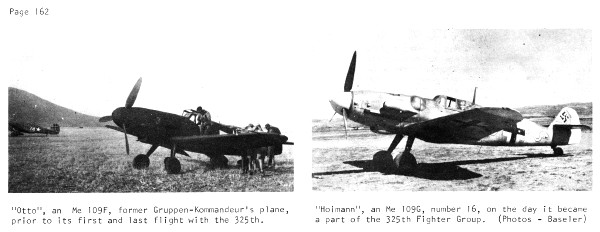
What's this? An all-black Me-109 being attended to by 325th personnel?
Why, yes. Yes, it is.
Sadly, "Hoimann", it's not. The photo is from the top of the page of the previously referenced AAHS article, and per the caption, that's "Otto", a Bf-109F, just before it's first and last flight with the 325th. Here's a close-up:
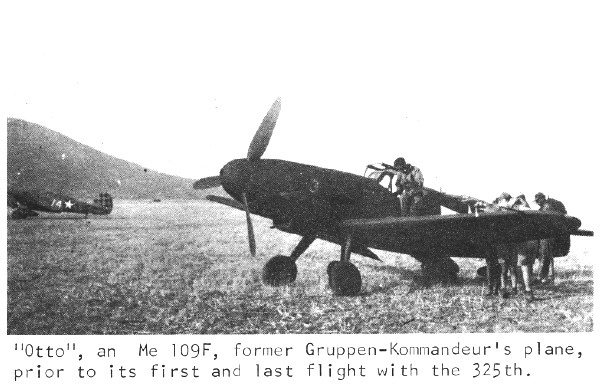
In the background on the left, you can just make out one of the checker-tail clan's P-40's with it's white star on blue circle insignia and checkerboard tail.
Here's a closer crop of "Otto" . . .

Sadly, the original reproduction of the photo in the AAHS article was too dark and too small to show any color details, other than a vague hint that the spinner might be a different color.
Far more interesting however, is something just barely visible on the aft fuselage, and that's the top edge and left corner of the ". . . standard American markings". The star-and-bar standard American markings. This is interesting because even in the poor quality previous uncropped photo, you can see that the P-40 in the background still has the older style insignia of white star in a blue circle with no white bar, while just barely visibly above "Otto"'s aft fuselage is another aircraft that distinctly does have the "star-and-bar" insignia. Sadly, it's too small and indistinct to tell what type aircraft it is. It's possible it could be the 109G "Hoimann", although it's not likely - it appears to be not black, but a lighter color, and also looks to have a checkertail, although most of the tail is hidden by people. There's no doubt about "Otto" though - it definitely has star-and-bar" American insignia. Here's a close-up:
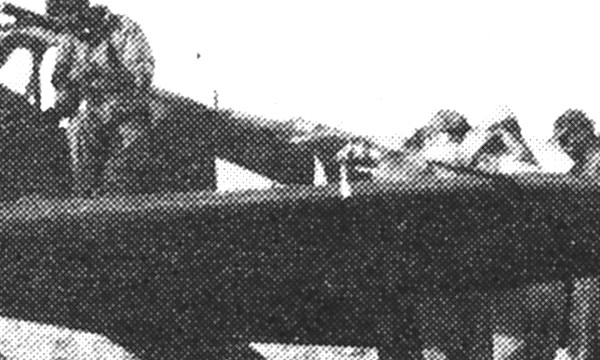
 If you're not quite sure what you're looking at (and that's pretty easy due to the poor photo quality reproduction), I've pointed out the important bits here . . .
If you're not quite sure what you're looking at (and that's pretty easy due to the poor photo quality reproduction), I've pointed out the important bits here . . .
So . . . we know that "Otto" had star-and-bar insignia when there were still checkertails that had the old style insignia. What implications does that have for "Hoimann"? Obviously, the ". . . standard American markings" changed between the time the P-40's were painted, and the time "Otto" was painted, and maybe even before "Hoimann" was painted. Knowing a timeline could help, even if it is all supposition with no photographic proof.
We know when the 325th acquired "Hoimann" (yellow '16') from the AAHS article:
"The Me 109G they had named "Hoimann" in honor of Hermann Goering had been found in a wheat field two days after the surrender."
We know the date of surrender. From the same AAHS article, page 157, column two, paragraph 3:
On 13 May 1943 General Von Arnim surrendered the last Nazi forces in North Africa to bring that phase of the war to an end."
So on May 15th, the Bf-109G that would become "Hoimann" was found in a wheat field.
On June 29th, 1943 (June 28th, according to Peter M. Bowers), the standard American markings changed from a white star in a blue circle, to a white star in a blue circle with white side bars, all outlined in red. The red outline was changed to blue September 17, 1943, 82 days later (a little over two and a half months). Peter Bowers gives the date of September 5th for the change from red outline to blue outline. If the September 5th date is used, the 82 days drops to just 70 days. the progression of standard American markings is shown below.

Judging by the uncropped AAHS photo of "Otto", which showed at least two different versions of the "... standard American markings", the later star-and-bar type on both "Otto" and the aircraft just visible above the back of "Otto's" fuselage, and the earlier type on the P-40 in the background on the left, it appears that aircraft were painted in the scheme required when they needed painting. Because "Otto", the 109F, has the newer star-and-bar insignia, we can presume it was painted after either June 28th (if it had a red outline, which is not discernable from the photograph), or after September 5th (or 17th), if it had the blue outline (also not discernable from the photograph). Whichever it was, it was obviously during a time of markings transition, as shown by the two aircraft in the background. It is of course possble that the older-marking adorned aircraft in the background on the left was a non-flying junker that didn't need new markings, and all other aircraft had already had their insignia re-painted, in which case, "Hoimann" would also have the newer markings.
All that remains is to determine when "Hoimann" was painted. Sadly, unless an enterprising 325th serviceman's personal journal is found where he just happens to mention the exact date this occurred, we'll never know.
But I'm going to make a guess anyway, and since you already know I chose the later star-and-bar insignia just by looking at the first photo at the top of this post, here's my reasoning:
The aircraft may have been found on May 15th, but it wasn't flight-worthy. Time would have been required to put it right, and by the time "Hoimann" was repaired, the new American markings standard may have already been in effect. In the AAHS article is this description of the aircraft's condition when it was found:
"As there was a British airbase nearby, Maj. Baseler checked with them, since he felt they might have a prior claim to it, but they told him that they had taken what they wanted, namely the radio and battery, and the Clan had a 109 to test fly. It had been landed by the mortally wounded pilot, relatively intact. A single 20mm shell had gone through the upper longeron on the left side of the fuselage and exploded in the cockpit. Another had penetrated the left side of the fuselage and exploded against the laminated aluminum armor-plating behind the pilot, while a third one had pierced the fabric on the rudder. One tire had gone flat, apparently due to a hard landing. This was the extent of the damage. A new battery was put in along with a new radio and the damage was patched up. Later on, the Group obtained a 109F, "Otto", in which Maj. Baseler experienced a narrow squeak while giving the plane it's first flight. A number 6 rod on the right bank of cylinders broke and went through the crankcase and sheered off an oil line and the coolant line as well. It then caught fire and he had to belly it in but escaped injury, although "Otto" was written off so far as further flying was concerned."
So the future "Hoimann" had to be fixed a bit. Sounds fairly straight-forward from the descripton above, but probably not as simple as it was made out to be, I suspect because compared to some of the repair work they'd had to do to keep damaged P-40s combat-ready, it was a relatively easy task. Note that I said a relatively easy task. That's not the same thing as an easy task. Here's what needed to happen:
- The 109 had to be transported back to the 325th's base. A photo from the internet shows the "Yellow 16" Bf-109 in May 1943, minus it's wings. They had to dis-assemble it to transport it back to the base. Removing the wings is not a minor task to perform on an aircraft you don't have any manuals or training for. It'll take time, especially if you want to be able to put it back together again so that it'll fly. Catalog all the bits and pieces, where they came from, and store them in a logical way so they can be correctly re-installed later. After removing the wings and transporting it back to base, the repair work could begin.
- We know that the cannon pods were removed. That should be a relatively straight-forward task, since they weren't re-installed.
- "A single 20mm shell had gone through the upper longeron on the left side of the fuselage..."
Holes in longerons are not trivial things if you intend to fly a combat aircraft (or any aircraft for that matter). Yes, the mechanics are used to repairing battle damage, but longerons are major load-bearing pieces of structure, so repairing them is not a trivial thing. A proper job of it will take time.
- ". . . and exploded in the cockpit." Again, battle damage, but in an unfamiliar aircraft, so how do you determine what's essential and what's not? Fortunately, fighter controls and instruments were fairly universal, so fixing the essentials probably not a big deal, but yes, time-consuming to sort it all out.
- "Another had penetrated the left side of the fuselage and exploded against the laminated aluminum armor-plating behind the pilot." We don't care about the "... exploded against the laminated aluminum armor-plating ..." part. However, we do care about the "... had penetrated the left side of the fuselage ..." part. New fuselage skin, new rivets, etc., or even just a metal patch riveted on, it'll still take a little fabrication time.
- ". . . while a third one had pierced the fabric on the rudder." No big deal. The P-40F had fabric-covered control surfaces too, so the mechanics would be well-versed in this type of repair.
- "A new battery was put in along with a new radio . . ." Straight-forward, assuming that the battery was the same size and voltage, and didn't require altering any structural components. Radio installation would be easier, as you could substitute an entire U.S. radio system, again assuming operating voltages weren't different.
- "One tire had gone flat, apparently due to a hard landing." Easy fix. coupla days, max., even without official Messerschmitt tire-changing tools.
- Aircraft reassembly - gotta put them wings back on. Non-trivial, and time consuming. Controls, instruments, wiring - all have to be re-attached, tested, and proved safe and functional before you'll want to fly it again.
- NEW PAINT JOB! Finally. I figure in the desert, dust and dirt would be a real problem, so it needs to be done in a (non-existent) hanger. Barring that, at a time with no breeze, but once done, it'll dry pretty fast in that heat.
By the time all that work was done, on what was essentially a non-combat (low-priority) aircraft, a fairly significant amount of time would have passed, easily enough get 109G "Yellow 16" through the 44 days from it's May 15th discovery to the June 28th implementation date of the new "star-and-bar" insignia marking standard. With a *cough*red outline*cough*. 
More importantly, there's no date on the photograph of "Hoimann", so it could have been taken at any time, during any of the official markings periods, from the time the 325th finished repairing it (whenever that was), right through the time period after September 5th/17th, when the insignia changed to star-and-bar with a blue outline.
Since the "Hoimann" photo doesn't show any insignia at all, and barring another photo turning up which does show the insignia, it actually doesn't matter which insignia is used. Theoretically it could have had all three versions of the standard American markings painted on it at one time or another, and since it may have been re-painted after each change in markings standards, it likely did end up with the blue outline insignia.
With the above in mind, I chose to use "star-and-bar" insignia with a blue outline on my Bf-109G-6 "Hoimann".
That's my story, and I'm sticking to it. 
So here's the color scheme I elected to use: Black overall, with red spinner, ailerons, and rudder, the "Hoimann" nickname in white, white star-and-bar insignia with a blue outline, and gray-green wheel hubs, all as shown in the color profile below.

 Correct Placement of the Nickname "hoimann"
Correct Placement of the Nickname "hoimann"
The left-most part of the 'h' touching the panel seam, and on the right, the upper tropical filter support strut terminates in the top of the slot in the last 'n'.
|
The Build
 My research completed, all I needed was a 1/72 scale Me-109G kit for the project. I'd been down to Emil's Skyway Hobby to get some paint, and I remembered some old Airfix 109 bag kits. On the next trip of opportunity (never make sole-purpose trips!), I picked up one of those old Airfix Me-109G bag kits for a VERY reasonable price.
My research completed, all I needed was a 1/72 scale Me-109G kit for the project. I'd been down to Emil's Skyway Hobby to get some paint, and I remembered some old Airfix 109 bag kits. On the next trip of opportunity (never make sole-purpose trips!), I picked up one of those old Airfix Me-109G bag kits for a VERY reasonable price.
Going through my decal box produced a set of standard American markings from an old Revell kit that were exactly the right size. They were old, but I had some Microscale Industries Liquid Decal Film (decal restorer) (see picture), so I was all set.
Liquid Decal Film (decal restorer) ------------>
|
As is always the case, the best laid plans don't always come to pass. An out-of-town trip conspired to limit my building time, but on a kit this simple, it ended up not mattering much. With the exception of the nick-name "hoimann" on the nose (more on that later), it was a very straight-forward build.
I did add a couple of simple little details to make it fun . . .
 . . . one of which was using actual metal screen for the desert sand filter. Steve Gallacci, one of the local NWSM modelers of note, was able to provide the perfect screen for the filter.
. . . one of which was using actual metal screen for the desert sand filter. Steve Gallacci, one of the local NWSM modelers of note, was able to provide the perfect screen for the filter.
Scale supports for the front of the oil filter made from stretched sprue were also added, and the rear of the oil filter was slightly reshaped. The narrow metal strip visible on the side of the screen running from the aft intake section to the front cap was made from thin paper and glued to the screen. In retrospect, I could have used shim brass for a slightly neater look, but it looks okay as is. These simple improvements added greatly to the realism of the finished model.
|
 The cannon barrel in the spinner was also drilled out, another very simple, and gratifying improvement . . .
The cannon barrel in the spinner was also drilled out, another very simple, and gratifying improvement . . .
|
With the exception of a few minor changes and fixes, I left the rest of the kit as stock as possible in order to keep costs down and to meet the building deadline.
Those minor changes and fixes included the following:
- Sanding off most of the rivet detail
- Filling in the mounting slots on the bottom of the wing where the cannon gondola would have been attached, as this particular aircraft did not have the cannon gondolas mounted. (See photo here). The underwing cannon gondola would have been clearly visible under the (pilot's) right wing, along with the cannon barrel itself. It's presumed that the 325th personnel removed the gondolas, because one of three photos of the aircraft in May 1943, presumably taken shortly after it was acquired by the 325th, show the cannon gondolas still in place.
- The ventral engine air scoop molding was incomplete. When the fuselage halves were glued together, there was a significant indentation in the middle of the scoop, so I cut the bottom off the scoop, replaced it with a piece of sheet plastic, and sanded it smooth.
- The instructions show installing the prop/spinner by trapping the retaining pin between the fuselage halves. Since the prop-shaft hole in the fuselage was mis-aligned and mis-shapen, I elected to forego a spinning prop. The hole was enlarged, and the shaft in the spinner was replaced with a longer shaft wrapped with a small section of Tamiya yellow tape to give it a snug fit. After the airframe assembly and painting was finished, the prop assembly was pressed carefully into the hole in the front of the fuselage. Result: a much cleaner-looking fit and nose.
|
Painting "hoimann"
The most difficult part of the build was reproducing the nickmane "hoimann" on the nose. First I had to find a typeface that matched that shown in the photograph. Coreldraw has more typefaces than you can shake a stick at, and after going through the list several times, I chose 'Frankenstein' as the closest starting point, and then modified each individual letter to match the letters in the photo. The letters done, I matched the spacing, and then scaled it to size. In the photo, the left-most part of the 'h' touches a major panel seam, and on the right, the upper tropical filter support strut terminates in the middle of the last 'n'. In 1/72 scale (on the Airfix kit), the length worked out to 0.36 inches from the left-most side of the 'h' to the right-most serif on the last 'n', and the height worked out to about 0.083 inches from the bottom to the top of the 'h'. Here's the pattern I worked out in CorelDraw before reducing it to 1/72 scale . . .

|
 Not having an ALPS printer to print white decals, or access to someone who does, I decided to try cutting a stencil from Tamiya tape, and airbrush the white on.
Not having an ALPS printer to print white decals, or access to someone who does, I decided to try cutting a stencil from Tamiya tape, and airbrush the white on.
This didn't work very well. Even with a brand new #11 hobby blade, and a
specially-made magnifying lense set-up, the spacing between the uprights of the letters was just too small to keep from tearing the tape while cutting adjacent lines. You can see that the tip of a #11 blade is nearly as big as some of the cuts that need to be made! ------------>
|
 After a couple of tries, I decided on a modified approach - make a simpler stencil by cutting out the outside shape of the letters like this, ---->
After a couple of tries, I decided on a modified approach - make a simpler stencil by cutting out the outside shape of the letters like this, ---->
spray the letter 'blocks' white . . .
 . . . and after spraying the white, attempt to paint the black details of the letters (shown here as gray areas) using a tiny paintbrush. ----> . . . and after spraying the white, attempt to paint the black details of the letters (shown here as gray areas) using a tiny paintbrush. ---->
|
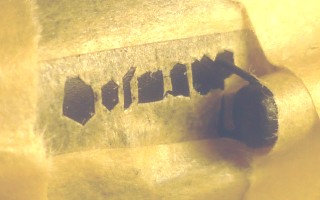 Using the new 'block' pattern, I eventually got a stencil that looked marginally like a 'hoimann' outline, lifted it off the cutting surface, and after mutliple tries, got it positioned in more or less the right spot.
Using the new 'block' pattern, I eventually got a stencil that looked marginally like a 'hoimann' outline, lifted it off the cutting surface, and after mutliple tries, got it positioned in more or less the right spot.
With the stencil properly positioned, I masked off the rest of the area. This would have been easier if I'd done it before attaching the tropical filter to the fuselage. 
|
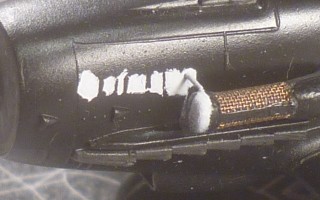 The stencil was then airbrushed flat white, using several very light coats, minimal air pressure and coverage, and letting each coat dry before repeating, until I got an opaque coverage. When the last coat was dry, I un-masked it, and was left with this ------>
The stencil was then airbrushed flat white, using several very light coats, minimal air pressure and coverage, and letting each coat dry before repeating, until I got an opaque coverage. When the last coat was dry, I un-masked it, and was left with this ------>
Not pretty, but, it's a start, and most importantly, it's the right size.
|
 Now it was time for the hard part - adding the details of the letters using a tiny paintbrush and flat black paint, then touching up with a bit of the flat white.
Now it was time for the hard part - adding the details of the letters using a tiny paintbrush and flat black paint, then touching up with a bit of the flat white.
The results? Not too bad. As finished on this 1/72 scale model, the name "hoimann" is only about 1/3 of an inch long, most of the letters are just over 1/32 of an inch tall, and even the tallest letter, the 'h', is still less than 3/32 of an inch tall. All-in-all, not too bad for such a tiny detail that was for all practical purposes mostly hand-painted!
The camera can see imperfections the naked eye can't, so it actually looks (a little) better in person. Even so, if you've got access to someone with an ALPS printer, by all means, have them print up a little decal for you, which you should put on before you add the tropical filter to the side of the fuselage. It will be much easier that way. 
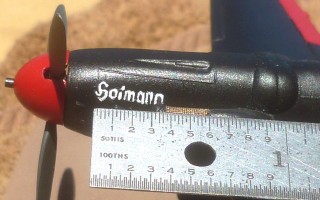
How small is it? This small !
(0.36" long)
|
The Display Base
The all-black shelves of the NWSM display cases presented a unique problem for this all-black model - it would disappear on the background. This issue was solved by making a light-colored base. Since the real aircraft was flown off a desert field, the base achieved a dual purpose - it represented the actual surface the aircraft flew from, and it provided a contrasting color under the all-black 109 to differentiate it from the all-black display case shelves.
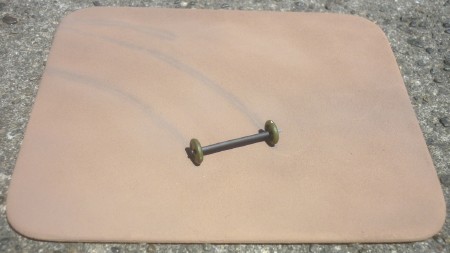 A five and a half by six inch piece of 1/8 inch thick fiberboard was used for the base. I had already planned on having wheel tracks leading to the 109's final position on the base. The tracks would curve, and the tail wheel track would show that the pilot had swung the '109 into it's final position. This required an exercise in graphical analysis to plot the wheel tracks, which were then transferred to a piece of paper, and the tracks cut out, leaving a mask in the shape of the eventual tracks.
A five and a half by six inch piece of 1/8 inch thick fiberboard was used for the base. I had already planned on having wheel tracks leading to the 109's final position on the base. The tracks would curve, and the tail wheel track would show that the pilot had swung the '109 into it's final position. This required an exercise in graphical analysis to plot the wheel tracks, which were then transferred to a piece of paper, and the tracks cut out, leaving a mask in the shape of the eventual tracks.
 To make the actual tracks, I made a simple wheeled bar with the wheels set the same distance apart as the 109's. The base was coated with thinned Elmer's glue, over which baking flour was liberally sprinked and pressed down. The wheel track pattern was placed over the base, and the wheel track device was rolled along the tire tracks cut into the paper wheel track pattern creating indentations in the "sand" to simulate the main wheel tire tracks in the not-yet-dry flour and glue mixture. The tail wheel track was added, and the base was set aside to dry. When the base was dry, it was sprayed with a light flat tan to represent the dirt/sand that the aircraft had to operate off of. The base finished, my 'Strangers in a Strange Land' Me-109G "hoimann" display was done.
To make the actual tracks, I made a simple wheeled bar with the wheels set the same distance apart as the 109's. The base was coated with thinned Elmer's glue, over which baking flour was liberally sprinked and pressed down. The wheel track pattern was placed over the base, and the wheel track device was rolled along the tire tracks cut into the paper wheel track pattern creating indentations in the "sand" to simulate the main wheel tire tracks in the not-yet-dry flour and glue mixture. The tail wheel track was added, and the base was set aside to dry. When the base was dry, it was sprayed with a light flat tan to represent the dirt/sand that the aircraft had to operate off of. The base finished, my 'Strangers in a Strange Land' Me-109G "hoimann" display was done.
|
More photos of my Bf-109 G-6 "hoimann" build . . .
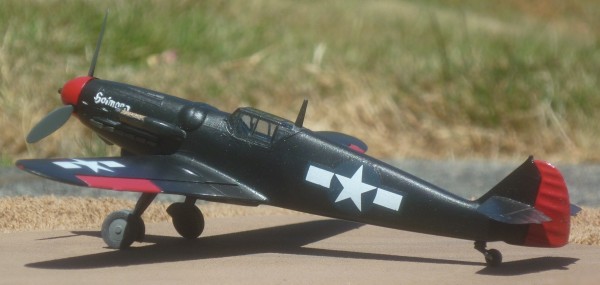
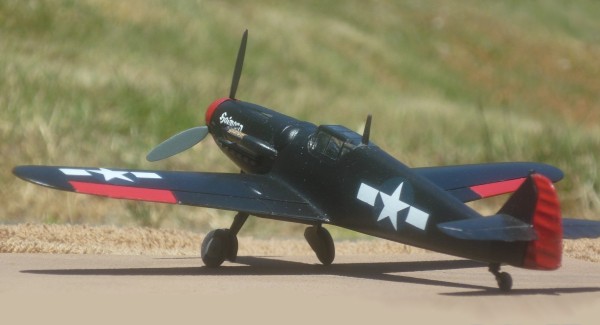

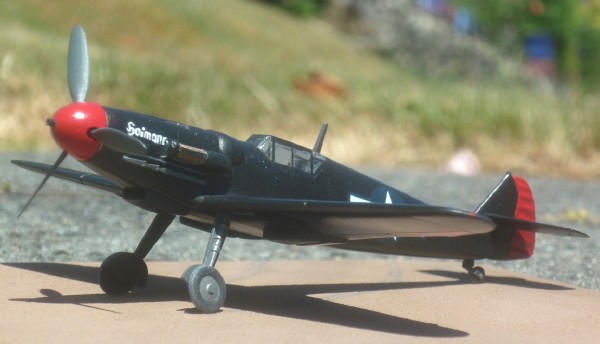
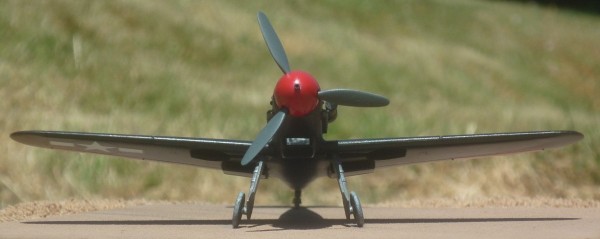

| |


 This fun little build was done for the July 2010 NWSM display at the Museum of Flight called "Strangers in a Strange Land", which displayed captured enemy aircraft in markings other than their own. In searching for a suitable candidate, I remembered an American Aviation Historical Society (AAHS) article about a couple of Me-109s captured in North Africa and painted in American markings, which would fit the bill perfectly. I rummaged about in my stack of reference materials, and there it was - in the Fall 1965, Vol. 10, No. 3 issue of the AAHS Journal, was an article entitled "Checkertails - History of the 325th Fighter Group Part I, August 1942 - May 1944", by Ernst R. McDowell. On page 162 of the Journal, the article included a short history, two photographs of captured Me-109s, and a description of how the Me-109G nick-named "Hoimann" was repainted in American markings.
This fun little build was done for the July 2010 NWSM display at the Museum of Flight called "Strangers in a Strange Land", which displayed captured enemy aircraft in markings other than their own. In searching for a suitable candidate, I remembered an American Aviation Historical Society (AAHS) article about a couple of Me-109s captured in North Africa and painted in American markings, which would fit the bill perfectly. I rummaged about in my stack of reference materials, and there it was - in the Fall 1965, Vol. 10, No. 3 issue of the AAHS Journal, was an article entitled "Checkertails - History of the 325th Fighter Group Part I, August 1942 - May 1944", by Ernst R. McDowell. On page 162 of the Journal, the article included a short history, two photographs of captured Me-109s, and a description of how the Me-109G nick-named "Hoimann" was repainted in American markings.





 If you're not quite sure what you're looking at (and that's pretty easy due to the poor photo quality reproduction), I've pointed out the important bits here . . .
If you're not quite sure what you're looking at (and that's pretty easy due to the poor photo quality reproduction), I've pointed out the important bits here . . .


 Correct Placement of the Nickname "hoimann"
Correct Placement of the Nickname "hoimann" My research completed, all I needed was a 1/72 scale Me-109G kit for the project. I'd been down to Emil's Skyway Hobby to get some paint, and I remembered some old Airfix 109 bag kits. On the next trip of opportunity (never make sole-purpose trips!), I picked up one of those old Airfix Me-109G bag kits for a VERY reasonable price.
My research completed, all I needed was a 1/72 scale Me-109G kit for the project. I'd been down to Emil's Skyway Hobby to get some paint, and I remembered some old Airfix 109 bag kits. On the next trip of opportunity (never make sole-purpose trips!), I picked up one of those old Airfix Me-109G bag kits for a VERY reasonable price. . . . one of which was using actual metal screen for the desert sand filter. Steve Gallacci, one of the local NWSM modelers of note, was able to provide the perfect screen for the filter.
. . . one of which was using actual metal screen for the desert sand filter. Steve Gallacci, one of the local NWSM modelers of note, was able to provide the perfect screen for the filter. The cannon barrel in the spinner was also drilled out, another very simple, and gratifying improvement . . .
The cannon barrel in the spinner was also drilled out, another very simple, and gratifying improvement . . .
 Not having an ALPS printer to print white decals, or access to someone who does, I decided to try cutting a stencil from Tamiya tape, and airbrush the white on.
Not having an ALPS printer to print white decals, or access to someone who does, I decided to try cutting a stencil from Tamiya tape, and airbrush the white on. After a couple of tries, I decided on a modified approach - make a simpler stencil by cutting out the outside shape of the letters like this, ---->
After a couple of tries, I decided on a modified approach - make a simpler stencil by cutting out the outside shape of the letters like this, ----> . . . and after spraying the white, attempt to paint the black details of the letters (shown here as gray areas) using a tiny paintbrush. ---->
. . . and after spraying the white, attempt to paint the black details of the letters (shown here as gray areas) using a tiny paintbrush. ----> Using the new 'block' pattern, I eventually got a stencil that looked marginally like a 'hoimann' outline, lifted it off the cutting surface, and after mutliple tries, got it positioned in more or less the right spot.
Using the new 'block' pattern, I eventually got a stencil that looked marginally like a 'hoimann' outline, lifted it off the cutting surface, and after mutliple tries, got it positioned in more or less the right spot. The stencil was then airbrushed flat white, using several very light coats, minimal air pressure and coverage, and letting each coat dry before repeating, until I got an opaque coverage. When the last coat was dry, I un-masked it, and was left with this ------>
The stencil was then airbrushed flat white, using several very light coats, minimal air pressure and coverage, and letting each coat dry before repeating, until I got an opaque coverage. When the last coat was dry, I un-masked it, and was left with this ------> Now it was time for the hard part - adding the details of the letters using a tiny paintbrush and flat black paint, then touching up with a bit of the flat white.
Now it was time for the hard part - adding the details of the letters using a tiny paintbrush and flat black paint, then touching up with a bit of the flat white.
 A five and a half by six inch piece of 1/8 inch thick fiberboard was used for the base. I had already planned on having wheel tracks leading to the 109's final position on the base. The tracks would curve, and the tail wheel track would show that the pilot had swung the '109 into it's final position. This required an exercise in graphical analysis to plot the wheel tracks, which were then transferred to a piece of paper, and the tracks cut out, leaving a mask in the shape of the eventual tracks.
A five and a half by six inch piece of 1/8 inch thick fiberboard was used for the base. I had already planned on having wheel tracks leading to the 109's final position on the base. The tracks would curve, and the tail wheel track would show that the pilot had swung the '109 into it's final position. This required an exercise in graphical analysis to plot the wheel tracks, which were then transferred to a piece of paper, and the tracks cut out, leaving a mask in the shape of the eventual tracks. To make the actual tracks, I made a simple wheeled bar with the wheels set the same distance apart as the 109's. The base was coated with thinned Elmer's glue, over which baking flour was liberally sprinked and pressed down. The wheel track pattern was placed over the base, and the wheel track device was rolled along the tire tracks cut into the paper wheel track pattern creating indentations in the "sand" to simulate the main wheel tire tracks in the not-yet-dry flour and glue mixture. The tail wheel track was added, and the base was set aside to dry. When the base was dry, it was sprayed with a light flat tan to represent the dirt/sand that the aircraft had to operate off of. The base finished, my 'Strangers in a Strange Land' Me-109G "hoimann" display was done.
To make the actual tracks, I made a simple wheeled bar with the wheels set the same distance apart as the 109's. The base was coated with thinned Elmer's glue, over which baking flour was liberally sprinked and pressed down. The wheel track pattern was placed over the base, and the wheel track device was rolled along the tire tracks cut into the paper wheel track pattern creating indentations in the "sand" to simulate the main wheel tire tracks in the not-yet-dry flour and glue mixture. The tail wheel track was added, and the base was set aside to dry. When the base was dry, it was sprayed with a light flat tan to represent the dirt/sand that the aircraft had to operate off of. The base finished, my 'Strangers in a Strange Land' Me-109G "hoimann" display was done.




